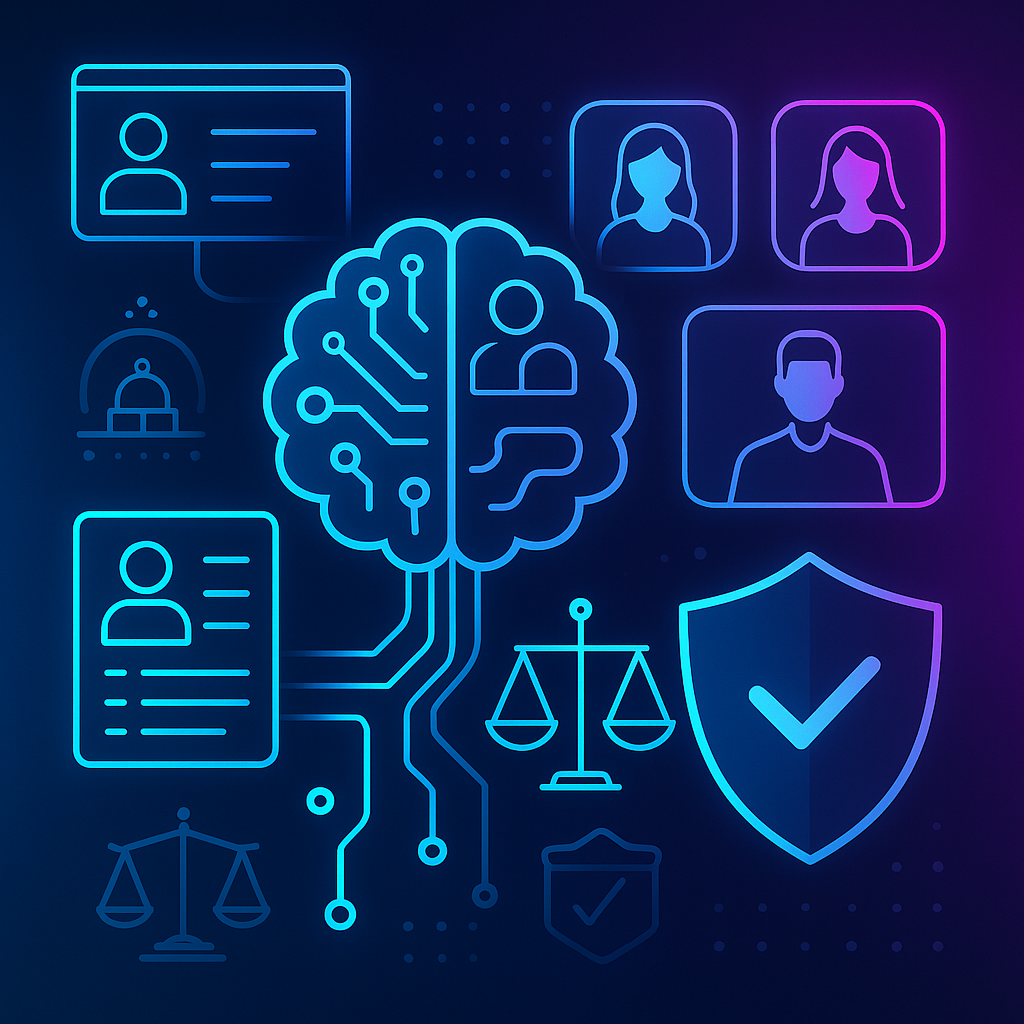AI Bias in Hiring: What Talent Leaders Must Know to Stay Compliant in 2025
Artificial intelligence is reshaping how organizations recruit, screen, and hire. But as adoption accelerates, AI is also under intense scrutiny from policymakers. From Washington, D.C. to state legislatures across the country, new laws are emerging to ensure that AI is fair, transparent, and free from bias.
For human resources and talent acquisition leaders, this regulatory wave creates both risk and opportunity. Those who adopt AI tools built with fairness and compliance in mind will be positioned to hire faster, reduce costs, and protect their brand reputation. Those who don’t risk falling behind, or worse, facing legal challenges.
As businesses integrate AI into recruiting, a spike in litigation is inevitable. One case in particular is already shaping the conversation.
What Should Recruiters Know About Mobley v. Workday?
In the AI bias lawsuit Mobley v. Workday, Inc., plaintiffs alleged the AI-driven applicant screening system disproportionately disqualified individuals over 40 from job opportunities. They sought collective certification under the Age Discrimination in Employment Act (ADEA) on behalf of all applicants aged 40+ who had applied through Workday’s platform since 2020.
On May 16, 2025, Judge Rita Lin of the Northern District of California granted preliminary certification of the collective. She found sufficient evidence that the AI system was central to the hiring process and that applicants were forced to compete on unequal footing due to the same AI-based decision-making process.
Although the decision is preliminary it is a landmark moment in AI and employment law. It illustrates how courts are willing to hold platforms accountable for algorithmic bias, even when hiring decisions vary by employer or job type.
This case, combined with the rise of Black unemployment to 7.5% in August 2025, which has sparked concerns about AI bias and equity in hiring, shows why regulatory bodies and employers are pushing for greater fairness, transparency, and oversight in AI-driven recruiting systems.
[Download Our Bias Audit Report] to see our full compliance with NYC’s AI Bias Law.
What is the Federal AI Action Plan?
In July 2025, the Trump administration released its much-anticipated AI Action Plan, outlining 90 policy positions across three key pillars:
- Accelerating Innovation – boosting AI R&D investment, promoting open models, and streamlining regulation to speed adoption.
- Building American AI Infrastructure – expanding secure data centers, upgrading the power grid, and strengthening workforce training.
- Leading in International Diplomacy and Security – setting global standards and exporting the “American AI Technology Stack” to allies.
Running through all three pillars are cross-cutting priorities: protecting American workers, ensuring AI systems remain unbiased, and safeguarding AI against misuse.
The Executive Order on Unbiased AI
Subheading: Federal AI Action Plan: Compliance and Oversight in Hiring
Alongside the AI Action Plan, President Trump signed a new Executive Order on Unbiased AI Principles. This order frames AI as a transformative force in education, work, and daily life but warns that ideological biases can distort its outputs. Specifically, the order cites “diversity, equity, and inclusion (DEI)” frameworks as a threat to reliable AI, alleging that they encourage distortion of historical accuracy and inject social agendas into model behavior.
To prevent this in federal procurement, the order sets two guiding principles:
- Truth-Seeking: AI systems must prioritize factual accuracy, objectivity, and transparency about uncertainty.
- Ideological Neutrality: Large language models (LLMs) must not encode partisan or ideological judgments unless explicitly prompted by the user.
What Does Federal AI Hiring Compliance Mean for You?
Federal agencies must now procure only LLMs that comply with fairness and transparency principles, with OMB issuing strict implementation guidance. AI contracts will require compliance clauses, and violations could trigger termination or penalties.
In short: AI innovation at the federal level is encouraged—but systems must pass bias audits in recruiting, meet AI in hiring compliance standards, and align with evolving AI employment laws to reduce risk of AI bias lawsuits and strengthen HR tech compliance.
2025 State AI Bias Laws Impacting Recruiting
While Washington emphasizes speed and competitiveness, states are moving quickly to implement tougher AI safeguards. These AI employment laws have direct implications for how employers and vendors use AI in recruiting:
- California (AB 2013): Requires AI developers to disclose the datasets used in training, effective 2026.
- Colorado (SB24-205): Imposes strict risk management and consumer rights requirements for “high-risk” AI in areas like employment, starting February 2026.
- Connecticut (SB 2): Requires employers to notify job applicants when AI influences hiring decisions, provide explanations, and allow appeals.
- Illinois (HB5322): Mandates annual bias audits and impact assessments for AI used in hiring, promotion, and pay decisions beginning January 2026.
- Maryland: Requires state agencies to conduct pre-deployment bias testing, continuous monitoring, and human oversight for high-risk AI systems.
- New York: Moving toward one of the strictest regimes—independent audits, Attorney General filings, whistleblower protections, and bans on discriminatory AI.
The takeaway? AI employment laws in 2025 are evolving, and by 2026 any employer or vendor using AI in recruiting will need to demonstrate bias audits in recruiting, along with bias testing, transparency, and candidate rights protections.
What This Means for Recruiting Technology
This mix of federal innovation mandates and state bias safeguards creates a complex landscape. For talent leaders, it means:
- Choose AI tools and vendors that are auditable and transparent.
- Prepare for bias assessments and third-party audits.
- Give candidates clear notice, explanations, and appeal rights when AI is part of the hiring process.
At Leoforce, these principles are already baked into our platform. Our outcome-based recruiting solutions, powered by Ira, the Interactive Recruiting Agent, combine AI speed with human oversight to deliver high-quality candidates without bias.
Leoforce: AI Recruiting That’s Fair by Design
As a minority-owned company, we believe fairness and equity should never be optional. That’s why we engineered Leoforce to be bias-resistant from the ground up:
- Bias-Resistant by Design: We never use protected attributes like age, race, gender, or ethnicity in training or decision-making. Candidates are evaluated solely on skills, experience, and role relevance.
- Continuous Fairness Testing: Monthly A/B testing ensures consistent, unbiased outcomes and guards against model drift.
- Audit-Ready Infrastructure: Our systems are built to meet regulatory requirements and are certified by independent third parties.
Certified Fairness at Scale
Leoforce has undergone a formal third-party bias audit, with results confirming that our candidate outputs are unbiased and fully compliant with the New York City Council AI Bias Law (File Int 1894-2020 Version-A).
With this certification, our customers benefit from:
- Bias-free sourcing at scale
- Fair candidate evaluations without manual intervention
- Confidence in compliance across multiple jurisdictions
[Download Our Bias Audit Report] to see our full compliance with NYC’s AI Bias Law.
The Bottom Line
AI in recruiting is no longer just about efficiency. It’s about fairness, compliance, and trust. Federal policy is pushing companies to innovate faster, while states are demanding stronger safeguards against bias.
At Leoforce, we believe fairness isn’t a feature—it’s a foundation. Our certified, bias-resistant AI helps HR leaders hire faster, better, and more fairly so they can scale confidently in an evolving regulatory landscape.





